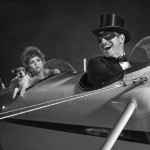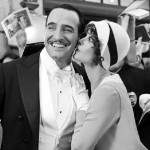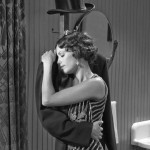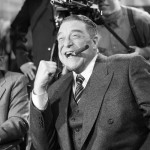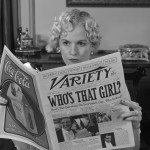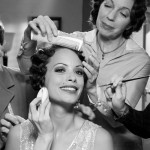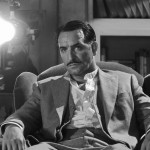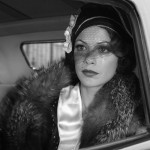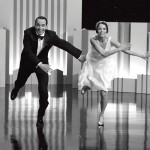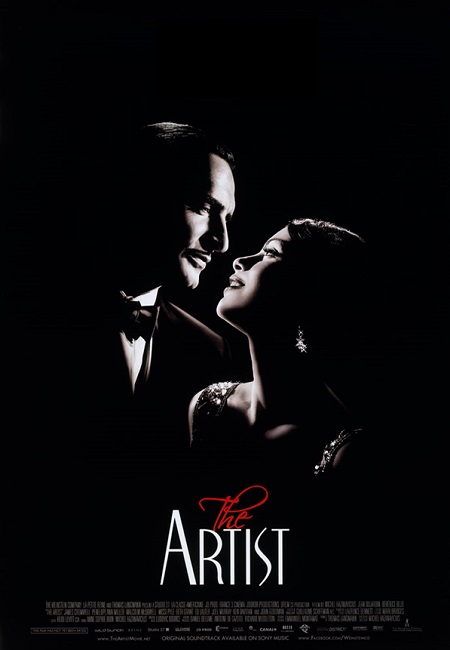
The Artist – 2011
The Artist is a gimmick that was designed to remind the Academy of the early days of Hollywood. It was a black and white silent film. In fact, it was the first black and white Best Picture winner since Schindler’s List in 1993, and the first silent film since the very first Best Picture winner in 1928, Wings. It was tailor made to touch the hearts of any movie buff who enjoyed films from the silent era. It was a blatant attempt to give them feelings of intense nostalgia.
And darn it if it didn’t work. The artist was nominated for 10 awards and won 5 of them. In addition to Best Picture, it won for Best Director (Michel Hazanavicius), Best Actor (Jean Dujardin), Best Costume Design and Best Original Score. So, it wasn’t a sweep, but it certainly took home its share of Oscars.
The film starred Dujardin as George Valentin, a big Hollywood star in the era of silent movies. He was American Royalty in its truest sense. He had everything: money, cars, a chauffer, a mansion, thousands of adoring fans and a beautiful wife. Unfortunately, he also had a number of traits that are sometimes typical of someone in such a position. He had an enormous ego and a callous disregard for most other people that bordered on just plain mean. True, he had a thousand-watt smile that was perfect for a silent film star, but he only turned it on when the public could see him.
He had all the graces and flaws that one might expect of a Hollywood superstar, which is why, as he is signing autographs, a young and unknown actress literally bumps into him. By today’s standards, such an accidental physical contact would be ignored, but in 1927, apparently, it is enough to make people gasp and recoil. But Valentin plays it off as something forgivable. He even poses for several pictures with the beautiful young stranger.
The woman’s name is Peppy Miller, played by Berenice Bejo. And, of course, the movie that Valentin is promoting is nearly forgotten because all the papers want to know is: Who’s that girl? The next day Peppy turns up at the movie studio and she turns heads with her bright smile and her talent for dancing. But Al Zimmer, played by John Goodman, the director of Valentin’s films, is upset at Peppy for overshadowing his new movie and refuses to work with her until Valentin vouches for her. Valentin is moderately attracted to her despite the fact that he is married to the beautiful Doris Valentin, played by Penelope Ann Miller.
Not long after that, as Peppy begins to get noticed, the real conflict of the film makes itself known. Zimmer calls Valentin into a private screening room to show the latest craze in filmmaking: talkies. The silent era was dying and sound was starting to take over Hollywood. But a prideful Valentin laughs in Zimmer’s face and walks out.
So, as you can see, the first half of the movie doesn’t really have much of a plot. It is simple and fairly dull. I am not a scholar of the silent film era, but it seems to me that in order for a movie, silent or otherwise, to be good there has to be a story content that hooks you in from the very beginning. Without that, a film just doesn’t keep my interest for very long. But maybe I am looking at the subject with too modern a sensibility.
I sometimes wonder how well the first Best Picture winner, Wings, would do at the box office if it were re-written for the audiences of today. Give it dialogue to make it more dramatic, color to make it more visually stunning, and maybe a science-fiction setting to appeal to a modern audience. I wonder how well it would do. I think it would do quite well because the story was a good one. But if you take the movie The Artist and gave it the same kind of treatment, I don’t think it would do as well. The plot was just too paper-thin. For me, the movie was a gimmick that wore off after the first half an hour.
The second half of the movie has much more substance and some deeper drama. It follows Peppy’s rise to stardom as she embraces the talkies, and Valentin’s decline into poverty as he refuses to do the same. But even then, the plot moves slowly and not very much happens. Valentin is fired by the studio, his wife leaves him and he loses everything. However, Peppy is still in love with him and she helps him as much as she can.
This is what justified the film and made me understand why it received all the awards that were given to it. This is where the characters became a little deeper and more believable. This is where reality stepped into the picture and I became much more invested in the characters. Eventually, Valentin attempts to commit suicide and is saved, in true silent film era fashion, by his dog. And we can’t have a movie like this without a happy ending.
I can’t really rate the performances of the actors based on the first half of the movie. But the second half gave me plenty on which to comment. Dujardin and Bejo both did a fantastic job. Dujardin was wonderful to watch as he spiraled down into the depths of depression and self-hate. But to me, it was Bejo who really stood out as a great actress. Peppy became a very conflicted character. She was riding the high and exciting wave of her own stardom, but her love for Valentin and her desire to help a man who, on several occasions, refused her help, afraid to accept the death of the silent film era, was a clear and somewhat compelling contradiction. It was very well played and I enjoyed watching her.
Some other notable actors in the film were John Goodman and Penelope Ann Miller. The scene in which Doris tries to tell George that she is unhappy in their marriage was very well acted. Miller displayed some of the strongest emotional power in the film. I actually felt bad for her character and when she turned on the tears, I nearly felt some myself. She impressed me.
Zimmer was a bit of a two dimensional character, but Goodman is such a good actor that he made it more than what was on the pages of the script. He has a very expressive face that worked quite well for a silent film. In fact, it occurs to me that all the actors had to re-learn how to act for a film format that hasn’t been used for over 80 years.
Another actor that stood out was James Cromwell, playing the part of Clifton, Valentin’s chauffer. He really looked perfect for the part and he portrayed a very loyal and likable character. Well done Cromwell!
There were several things about the movie that I found very effective. First of all, was the music. The original score had to cover the entire film, over 1 hour and 40 minutes. Granted, there was a little music borrowed from other films such as Alfred Hitchcock’s Vertigo and Alberto Ginastera’s “Estancia.” But it was always appropriate to the action taking place on the screen.
And finally, there are two scenes in particular that touched me and really caught my attention as being very well done. They stick in my memory and gave an extra dimension to an otherwise, let’s face it, monotone film. The first was just a very simple scene in which Peppy sneaks into Valentin’s dressing room to thank him for vouching for her with Zimmer. She writes a “thank you” note on his mirror but as she is leaving, she sees his tux coat hanging on a rack. She approaches it almost shyly and hugs it as if he is wearing it. She smells it and closes her eyes, imagining him to be standing in front of her. Then she puts her right arm into the sleve and wraps it around her left side. The simple illusion of the tuxedo sleeve against her gown is remarkable effective. It suddenly appeared as though someone else was caressing her and the look of bliss on her face was priceless. It was actually a magical little scene.
Interesting note: Apparently this little scene was an homage to a scene in 7th Heaven, a silent movie that was nominated for Best Picture in 1928, losing to Wings.
The other scene is the one in which Valentin is starting to realize that talkies are the future of cinema and the silent film era is nearly over. The music stops and all is silent. He is drinking and when he puts the glass on the table, you hear the sound effect as clear as day. It caught me off guard. It catches Valentin off guard as well. He picks up the glass and puts it down again only to hear the sound again. It is as if he has never heard a sound in his life. He starts hearing sounds all around him. But when he starts screaming into the mirror, trying to hear the sound of his own voice, no sound at all can be heard. Finally he sees a feather fall to the ground and the impact is so loud that he grabs his ears in pain. It was a very effective scene.
Something else that I could not help but notice was the fact that the film went out of its way to be a black and white silent film. But all the films from that early era had a somewhat darker and grainier quality to the picture. This effect could have been easily achieved with today’s technology. However, the clear and smooth quality of the film never let me forget that this was a very modern film. This was neither good nor bad. It was just a decision made by the director, but it caught my attention.
Interesting note: There wasn’t a single zoom shot in the entire film, specifically because the technology for zoom shots did not exist at that point in film making. In addition, the movie was shot at a slower frame rate than most modern films, making the action on the screen appear to be slightly faster than normal, just like in the silent era. All this attention to details in mimicking the style, and yet…
All in all, it was a well-made movie, but the plot was a little lack-luster. The acting was good, but the black and white, silent film format was, in my opinion, a cheesy gimmick to remind me of something I’m glad we have moved beyond. Yes, it was an homage to the work that was done in the early days of filmmaking which made all modern films possible. I get that. I just don’t know if it was Best Picture material.
